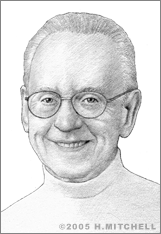Les Paul
One would be hard-pressed to find a guitar fan unfamiliar with the name Les Paul, who not only established himself as a renowned, pacesetting musician with a signature sound, but also contributed a number of advances in guitar design and recording processes, most notably with his invention of the solid-body electric guitar.
Born Lester William Polsfuss in Waukesha, Wisc., on June 9, 1915, he was hooked on music at an early age and sang for local organizations as a preschooler. As a child, Paul took piano lessons and taught himself how to play the harmonica, guitar, and banjo. He also had a natural curiosity and ability with things mechanical in nature and enjoyed making his own improvements to musical instruments. He built a recording machine with parts from an automobile and a dentist drill, as well as an amplifier made from radio and telephone components. As a high school student, Paul began experimenting with solid body electric guitars.
At the age of 13, Paul was performing semi-professionally. In high school, he joined a traveling band by the name of “Rube Tronson's Cowboys,” where he went by the stage moniker “Red Hot Red.” The band was comprised of adults and was sponsored by Chicago’s WLS radio. Paul dropped out of school to perform as “Rhubarb Red” with Wolverton's Radio Band at a station in St. Louis, Mo., where he worked with and was mentored by the talented Sunny Joe Wolverton. He relocated to Chicago and began performing jazz music as “Les Paul” in 1934, while continuing to play as Rhubarb Red on the radio. He assembled his first trio in 1937 and released his first two albums. Next, he moved to New York with his then-wife, Virginia Webb Paul, and became known as a performer on radio broadcasts of Fred Waring's Pennsylvanians until 1941. In 1943, he moved to Los Angeles, where he made a name for himself with a new group, the Les Paul Trio, and performed with big-time entertainers, including Nat King Cole and Bing Crosby.
By the 1930s, electric versions of hollow-body guitars had become widely available, and although Paul tried playing them, he was unsatisfied with the existing models. He was convinced that a solid body model was a viable concept and that this design would produce a better sound with reduced feedback and better sustainability for notes and chords. He built his first prototype, called “the rail” out of a piece of rail from a train track when he was in high school. Ten years later, while living in New York, he created a more advanced prototype out of a 4” x 4” piece of wood and an Epiphone guitar neck that he called “the Log.” He performed with his own specially designed guitars, but at the time, guitar companies showed little interest in creating a solid body electric guitar. He approached the Gibson Musical Instrument Co. with his designs in the early 1940s, but the company was doing well with its arched, hollow-body electric models, and so, it rejected his proposals.
Paul was encouraged to press on by others in the business, including fellow inventors, Leo Fender, and Paul Bigsby. Bing Crosby convinced him to set up his own studio and record his own masters. He began experimenting with recording devices en route to his breakthrough development of the concept of multi-track recording, which allowed musicians to play and record multiple parts of a song. In February 1948, Capitol Records released "Lover (When You're Near Me),” the first-ever multi-track recording release, featuring Paul playing eight different parts on the electric guitar. He played six parts himself in his 1948 hit, "Brazil,” from the alternate side of the same record. In 1953, he and recording partner Mary Ford, whom he had married in 1949, released their hit, a cover of "How High the Moon," which sold 1.5 million copies. Paul worked on perfecting the multi-track recording system until 1957, and the music industry has relied heavily on the multi-track system for studio recording ever since.
Meanwhile, in 1951, Leo Fender released a solid-body electric guitar called “the Broadcaster,” and competition inspired Gibson to seek Paul’s help in launching a comparable product. A collaboration employing Paul’s original ideas led to the 1952 launch of Gibson’s “Les Paul Model,” which was an incredible success and has been subsequently used by musicians around the world. Ted McCarty, a member of Gibson, was issued U.S. patent No. 3,018,680 for the Solid Body Electric Guitar in 1955, although Paul contributed a great deal to the solid-body design. Paul’s innovations went far beyond the solid-body guitar and multi-track system. His musical breakthroughs include sound-on-sound recording, overdubbing, reverb effects, and the use of the echo chambers, which are still used today. His ideas are said to have helped define the blues rock-and-roll sound of the late 1960s and 1970s and to have helped drive style for recording artists in rock, blues, country, alternative, and metal music well into the 1990s and beyond.
After dozens of hit albums and musical milestones, Paul went into semi-retirement in 1964 but returned to the scene several times in later years for recordings with Chet Atkins in 1976 and the Guitar Monsters in 1978, followed by regular trio performances in New York City from 1984 up until two months before his death. He has been honored with a number of awards for his achievements, including his 1979 induction, with Ford, into the Grammy Hall of Fame, induction into the Rock and Roll Hall of Fame in 1988, and induction into the National Inventors Hall of Fame in 2005. He was also awarded the John Smithson Bicentennial Medal from the Smithsonian Institution in 1996.
Paul died on August 12, 2009 in White Plains, NY. The Les Paul Foundation was established to inspire innovative and creative thinking by sharing the legacy of Les Paul through supporting music education, engineering and innovation as well as medical research.


